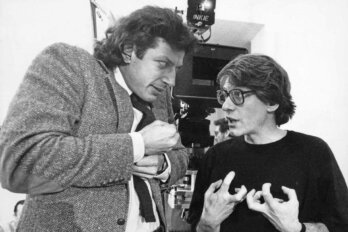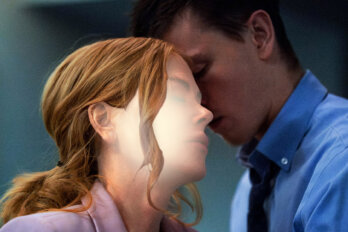Last april, two weeks before the opening of this year’s Venice Biennale, the National Gallery of Canada (NGC) announced a $3 million restoration of the deteriorating, sixty-year-old Canada Pavilion. Visitors arrived at the event, which could be considered the Olympics of art, to find a building disassembled. There was no longer much of a facade. Portions of the roof had been lifted off. A terrazzo floor was covered by a layer of masegni stones. Throughout the opening week, some visitors could be forgiven for wanting to commiserate with the exhibiting artist, Geoffrey Farmer, on the seemingly difficult circumstances while also congratulating him on his achievement. But this was precisely the building that Farmer had wanted—and helped create.
Farmer, fifty, is Canada’s foremost installation artist. In the past decade, he has filled a room at the Louvre with intricate figures cut out from an art-history textbook, turned odds and ends into animatronic sculptures, and collaged bits of fabric and found images into the most unsettling hand puppets you’ve ever seen. He reshapes galleries to suit his ends, building huge plinths and transforming rooms into new worlds for his projects. In another life, his obsessiveness and experimentalism might have made him a convincing mad scientist, but art seems to have been his destiny in this one. In the early 1990s, Farmer found himself in San Francisco surrounded by countercultural icons such as Kathy Acker and John Cage. Now based in Vancouver for almost three decades, Farmer has built an international following. “Geoffrey brings together various elements that can seem quite disconnected, but he finds paths between things and forges a kind of poetic structure out of disparate sources,” says England-based Hannah Rickards, herself an award-winning artist. Farmer doesn’t really make paintings or drawings or sculptures in themselves, although they often appear in his projects. What Farmer makes, more than anything, is sense: sense out of otherwise meaningless objects, sense out of a tangle of information.
When the NGC’s director and CEO Marc Mayer phoned Farmer in late 2015 to ask if he would carry the mantle for Canada at the 2017 event, Farmer immediately agreed. Twenty-nine countries have permanent buildings in Venice’s Giardini Pubblici, a park created by Napoleon, and every two years, each of them puts on an exhibition, trotting out their national best. Canada has experienced a relatively tough go in the fair over the years, in large part because of our midcentury, nautilus-shaped building—widely considered to be an unwieldy place to present work—and a lack of public funding compared to other nations. But in 2017, Canada had Farmer. And Farmer had something to work with.
A year ago, Farmer’s older sister, the Vancouver artist Elizabeth Topham, emailed him two photographs. The pictures, which their father had found while sorting through their grandmother’s effects, are striking: black-and-white shots of an empty GMC flatbed truck rammed into a ditch by a train. Lumber planks flung off the truck are scattered around the scene, and a railway-crossing sign, knocked aside during the collision, leans over the driver’s side of the dented vehicle. Their grandfather had been driving the truck. It’s believed that his chest hit the steering wheel, and while he managed to walk away from the scene of the accident, a few months later, he died of a heart attack. This May, these images, sixty-odd years old, took on another life as the catalyst for Farmer’s artwork in the world’s oldest and stateliest exhibition.
Farmer’s family had never discussed his grandfather’s accident, but its effects were deeply felt in other ways. Farmer and his father had “a difficult relationship,” Farmer tells me. (Since his early twenties, Farmer has used his mother’s maiden name.) But finding the photographs made the difficulty of his father’s life palpable. “Understanding my father and what he went through as a child, growing up in poverty, in a working-class environment, losing his father. It broke me open emotionally,” he explains. “I have so much more empathy for what he went through.” It is a vulnerable admission from the often-elusive artist. Farmer speaks comfortably and thoughtfully with the press, yet he often shies away from self-revelation. In Venice, though, the artist mentioned this aspect of his family history at exhibition openings and dinners. Farmer, who has made a career of organizing the outside world, is now trying to make sense of his own.
Seventy-one brass “planks,” the only literal connection to Farmer’s source material, lean against the pavilion’s walls and sit stacked on the ground and atop other sculptures. Most of the planks spurt streams of water without warning, as if the pavilion were alive but injured. The building, as a whole, seems to have sprung a leak. A tiled fountain near the pavilion’s centre intermittently sprays a thirty-foot geyser of water, which glitters in the sunlight and sends linen-clad art patrons jumping out of reach throughout preview week.
The sculpture’s basin is modelled on the courtyard fountain at the San Francisco Art Institute, a formative location for Farmer, who studied there for a year in 1990. Other sculptures in the work, called A Way Out of the Mirror (the title a nod to Allen Ginsberg, a favourite poet of Farmer’s), loosely reference collisions in history—Farmer’s personal history in most instances, but also the colonial history of Canada and of the Venice pavilion site itself. A small bronze casting of a hole that Farmer dug into the pavilion’s foundation squirts water out front; a little bronze turtle carries a book and a burbling can of water on its back behind the central fountain; a rough, oversized praying mantis (purportedly a self-portrait of Farmer during his awkward adolescence) sits perched, posing with two books, on a log in a corner. An index could be made of all the small references that Farmer has secreted within each piece, but one allusion to family registers plainly: next to the courtyard fountain, axes and a chisel puncture an enormous, water-spewing grandfather clock.
“Growing up gay, and feeling like I existed outside of society, I always had a desire to be part of society,” Farmer says. “In the beginning, my interest in art was to somehow become part of the world.” One way to do that: take control of the images that depict it. For the 2012 edition of the major German exhibition Documenta (13), Farmer embarked on an epic installation titled Leaves of Grass. Working with a team that at one point included some ninety volunteers, he cut out more than 23,000 images from an archive of fifty years’ worth of Life magazines, glued each one carefully to a piece of miscanthus grass, and stood them upon a long, narrow table, creating a staggering overview of the world in pictures. “After the Documenta (13) project, I really felt that I had entered into the world somehow,” he says. It was time to find new ground. “I began to think about my own history. I just felt that it was time to be more introspective.”
But Farmer was also representing Canada during the sesquicentennial, and found himself grappling with the country’s colonial past. “This project has made me understand that I am complicit in history, and complicit in the events of the world, whether I’m touched by them directly or not,” he says. So, in early February, Farmer flew up to Nunavut. He had read reports from 2015 about the arson at Peter Pitseolak High School in Cape Dorset, a hamlet that also houses a world-renowned co-operative that produces Inuit prints and drawings. During his four-day visit, he spoke with local artists and community members and eventually made a request: that they allow elements of the school’s wreckage to be included in his final piece for A Way Out of the Mirror. With their permission, Farmer ventured to the dump with James Alariaq, the deputy mayor, and used a diamond-tipped saw on the school’s remains. He packed the warped rebar pieces into a duffel bag, dragged them back to Ottawa, and shipped them off to Switzerland and then to Venice, where they were nestled into a trough at the pavilion’s rear.
The collisions—cultural, familial, and historical—evoked in A Way Out of the Mirror have little in common, save for Farmer himself. “It’s my creation myth of how I became an artist,” he says. Born in 1967 in Vancouver, Farmer found himself aimless in his early twenties, until his sister brought him to an art class at a local community college. Something clicked. At the urging of the college’s teachers, he applied to the Emily Carr Institute of Art and Design (now Emily Carr University). During his time there, he formed a lasting friendship with fellow student Brian Jungen, who has himself earned plaudits for his boundary-pushing sculpture. Together, they devoured hours of film (a continued passion—Farmer’s personal Instagram feed is a curio collection of rare and old movie clips), learned from such instructors as the famed photo artist Ian Wallace, and began building art beyond the large, beautiful photographs Vancouver artists had become known for internationally.
Farmer began exhibiting shortly out of school and, almost immediately, started taking galleries apart. He pierced the walls of Vancouver’s Or Gallery in 1996 and strung lights through the holes to give the space a celestial effect. A black steel fireplace suspended in a 2005 exhibition at the Power Plant in Toronto fed a flue up through a cored-out portion of the cement ceiling. Walls that had never been touched at the Vancouver Art Gallery were taken out for his 2015 retrospective. “He’s somebody who has spatial ambition,” says Kitty Scott, a curator at the Art Gallery of Ontario, who oversaw the Venice piece and has worked with Farmer for twenty years. “He was always moving into places where maybe he shouldn’t necessarily be.” At the VAG, Farmer also avoided the customary exhibition tour: docents brought visitors down into the catacombs of the building—a former courthouse—to explore the archives, a frequent source of inspiration for the artist. “It’s always a new way of doing things with Geoffrey, so nothing is standard,” Daina Augaitis, chief curator at the VAG, tells me.
The NGC’s team initially suggested to Farmer that they could start preparing for the planned refurbishment of the Venice pavilion by deconstructing a few portions of it during his project. Maybe they could take away a little glass, they thought, or remove some of the interior. Farmer wanted to go further: he wouldn’t just make sculpture—he would make the pavilion disappear. “He actually pushed us on it,” says Gordon Filewych, the project designer for the refurbishment. “We told him what we thought was possible, and he said, ‘Well, can we take most of the roof off? Can we take the facade off?’” In a handful of months, while at the same time trying to negotiate draconian Venetian heritage regulations, Farmer and the NGC’s team equipped the pavilion—a space without so much as a toilet—with an invisible water reservoir, a pump room, and a complex water-control system. While plans for the site were being developed, Farmer headed to the Kunstgiesserei, a famed foundry in St. Gallen, Switzerland. Nine months went into perfecting each of the installation’s sculptures. When the holes drilled into the brass wooden planks were first tested, the water pressure was too low, resulting in a clean stream—unacceptable. The holes were reshaped, welded in a jagged, organic fashion, so the streams of water travelled along in varied paths. Nothing was standard, and nothing was overlooked. “I think it’s the best Canadian Pavilion ever,” Berlin-based Canadian artist AA Bronson told me after seeing Farmer’s work. It was certainly the best attended—a record 41,770 people visited the site in May.
Under one of the trees in A Way Out of the Mirror, an aluminum sculpture of a crumpled duvet lies heaped on the ground. There are no clues about its meaning, with the exception of one sentence in Farmer’s poetic, elliptical exhibition text: “A duvet freshly slept in by Karl after an LSD trip in the rock formations of the Maggi River, I had to drive us to the airport the next day.” The text feels like an intimate admission, until you realize that none of the particulars have been given away. Who is Karl? When did they do LSD? Why does the duvet matter? It sums up the organizing principle of the piece, which layers autobiographical details that feel revealing, but keeps the fully fleshed-out stories just beyond reach. Farmer may have entered the world at large, but his own world, for the time being, remains just out of view.
August 17, 2018: An earlier version of this story stated that Gordon Filewych was the architect leading the refurbishment of the Canada Pavilion. In fact, Filewych was the project director for the refurbishment as well as the installation designer for Farmer’s art project. The Walrus regrets the error.





